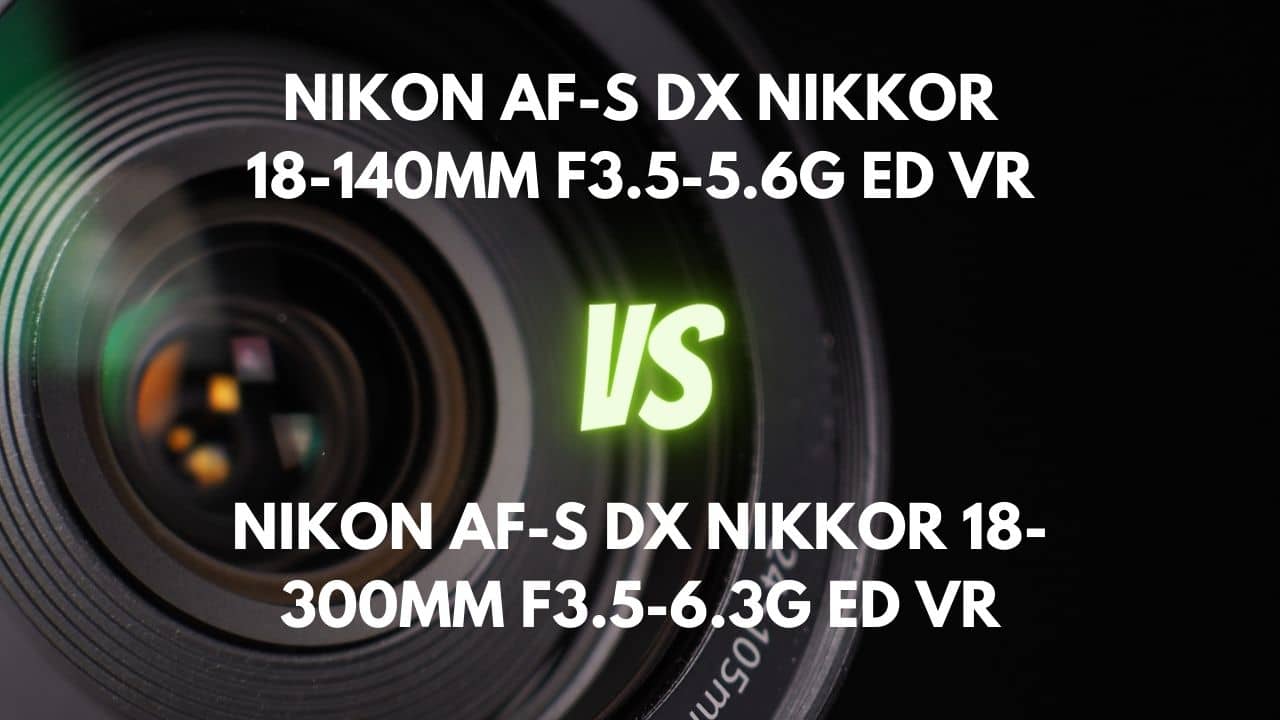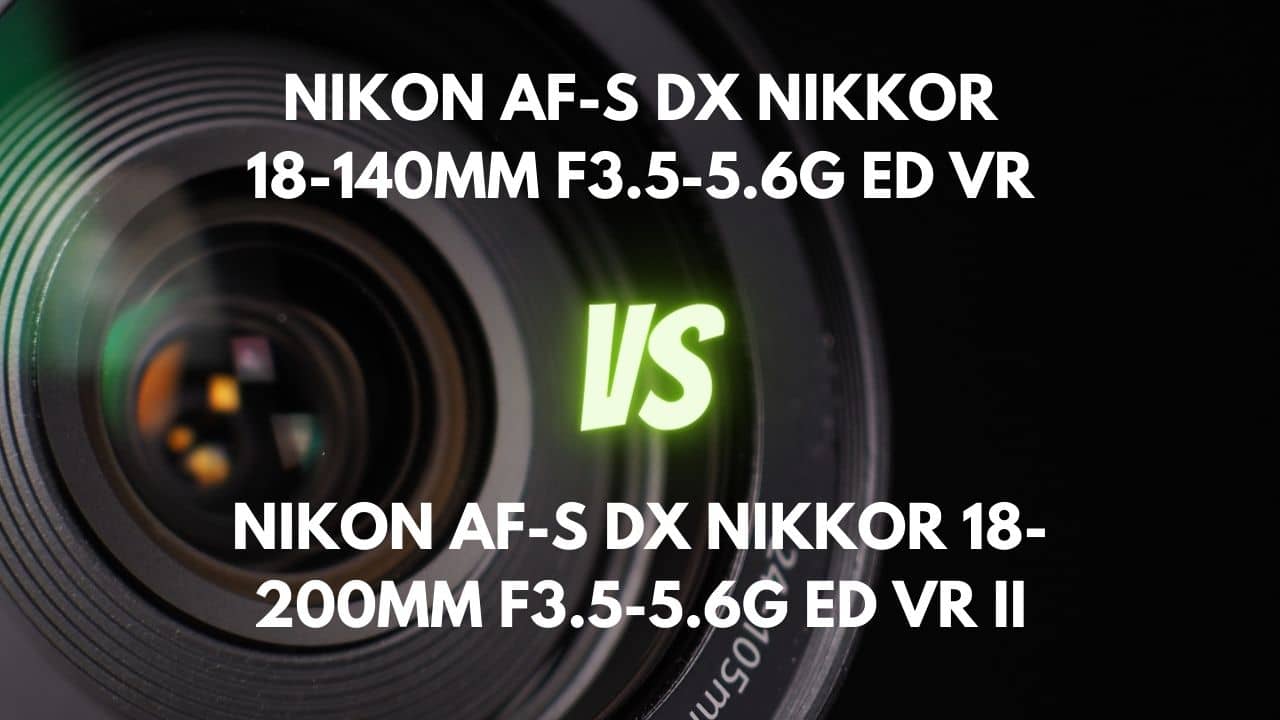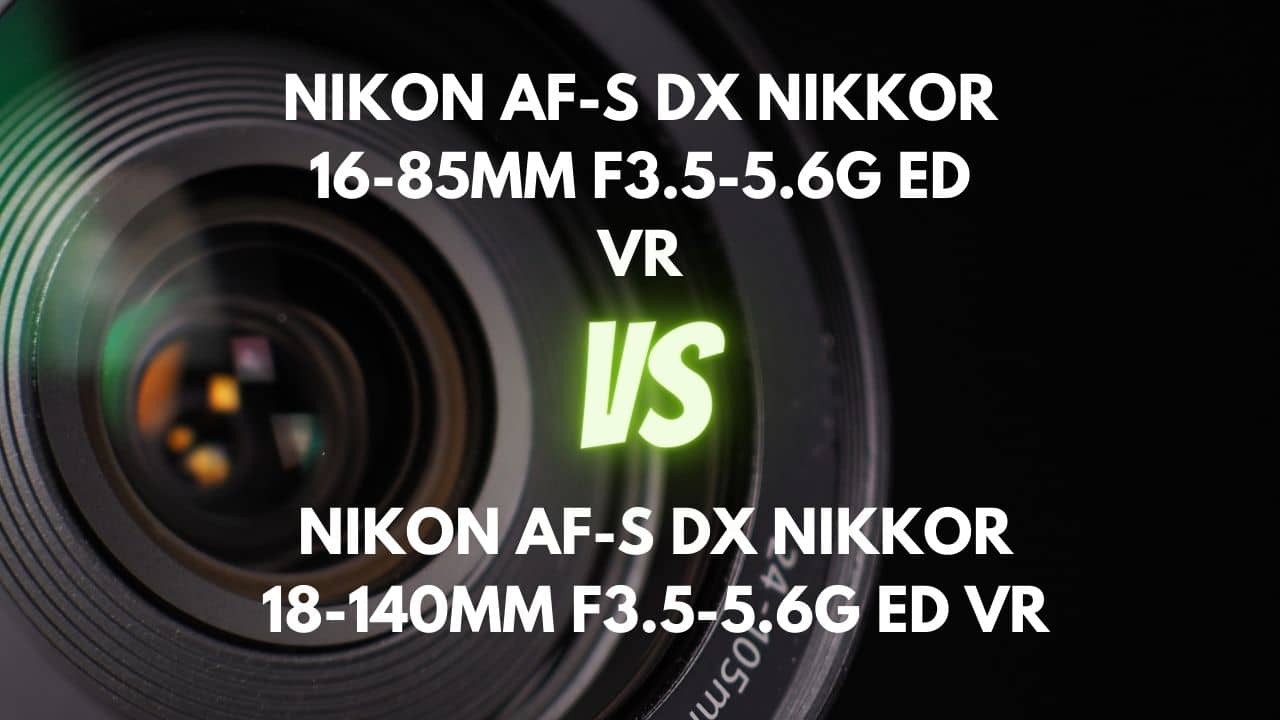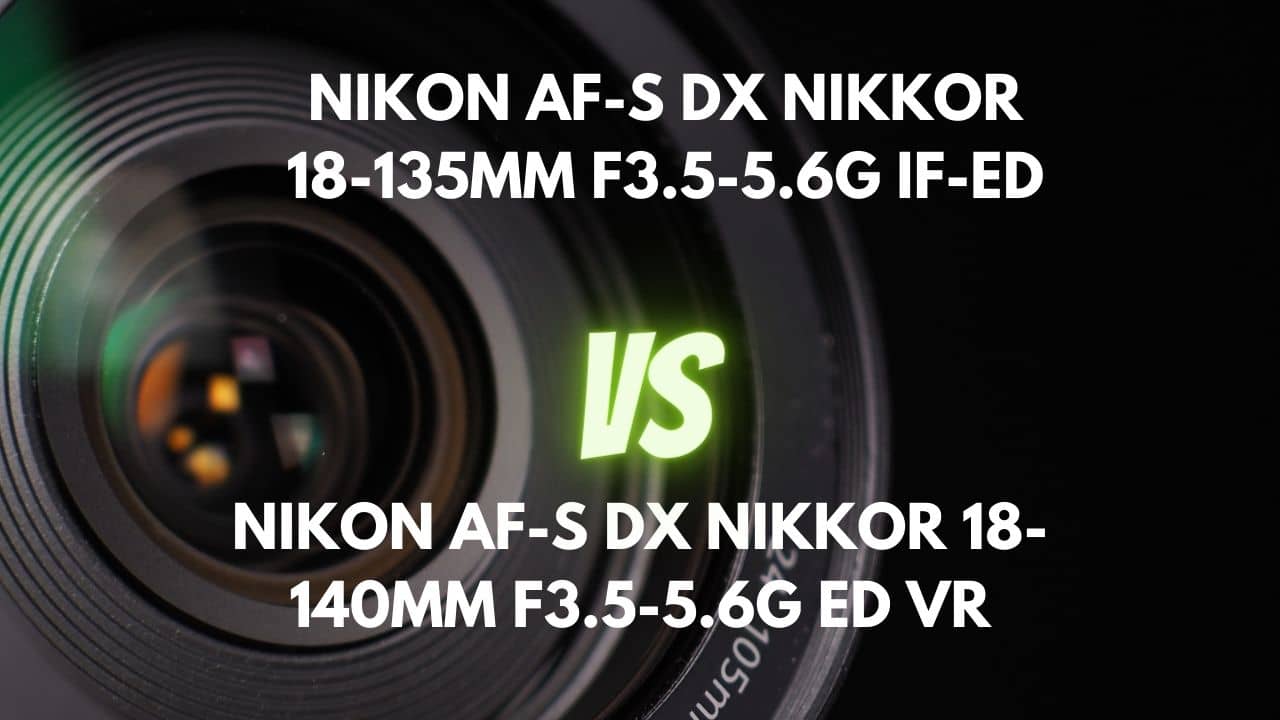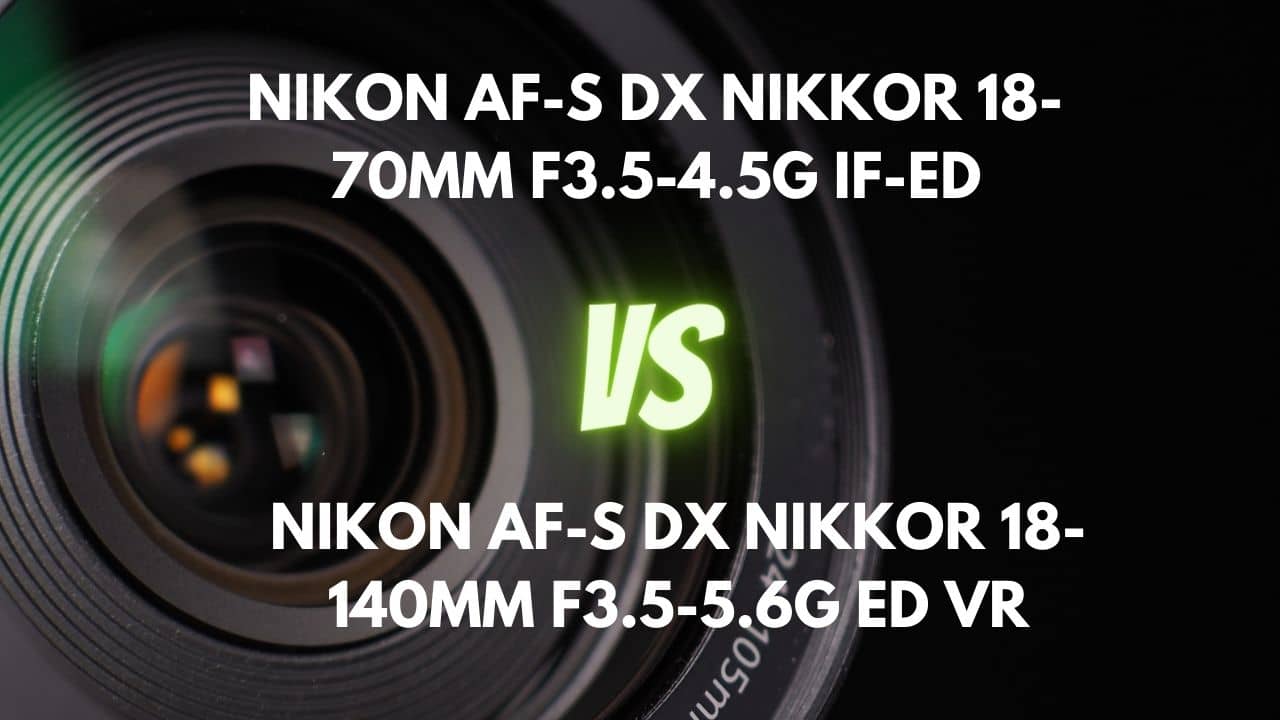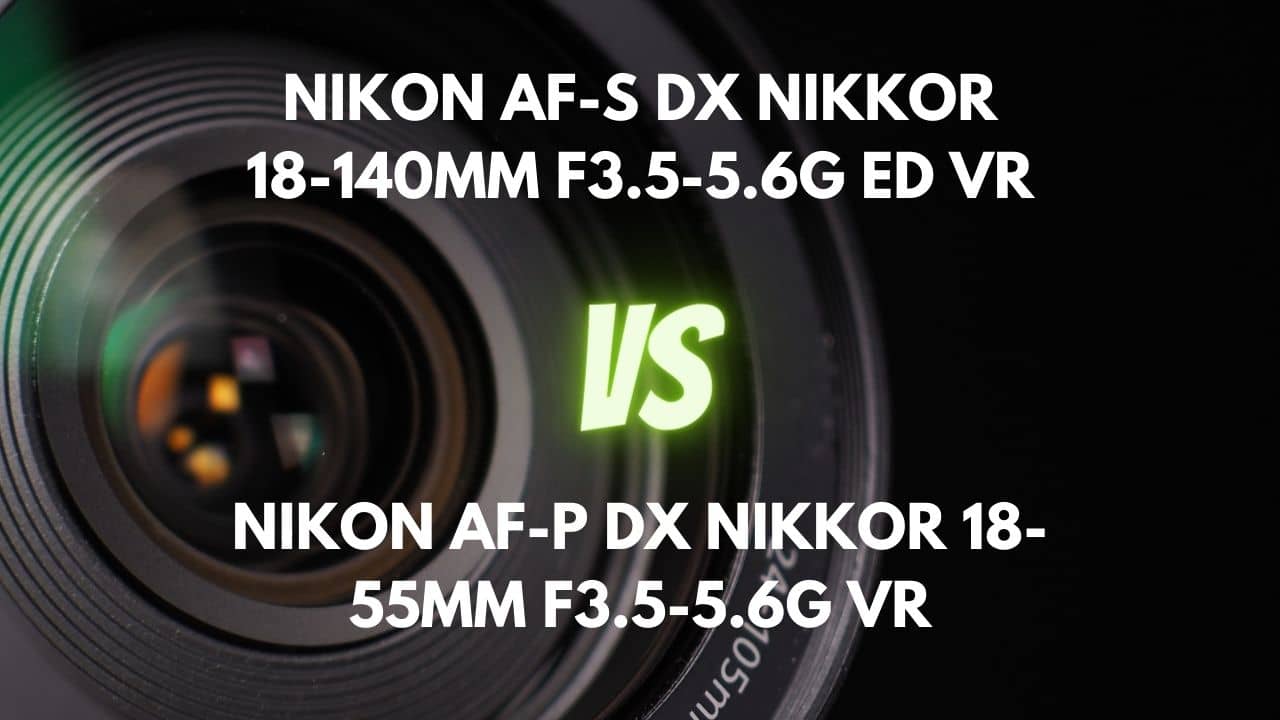Choosing the perfect lens for your camera can be a daunting task, especially when faced with multiple options that seem to offer similar features and capabilities. If you’re a photographer seeking a versatile lens that can tackle a wide range of photography styles, you might find yourself comparing the popular Nikon DX 18-105mm f/3.5-5.6 and Nikon DX 18-140mm f/3.5-5.6.
These lenses, often considered the “all-rounders,” cater to photographers who desire a single lens solution for capturing everything from sweeping landscapes and intricate architecture to intimate portraits and fast-paced events.
In this comprehensive comparison, we will delve into the nuances of these two versatile lenses, examining their strengths and weaknesses across various aspects such as portability, autofocus performance, optical stabilization, image quality, and more.
By understanding how these lenses perform in different photographic scenarios, you’ll be better equipped to choose the one that best aligns with your needs and preferences.
So, whether you’re an aspiring photographer looking to invest in your first multi-purpose lens or a seasoned professional exploring new options, this comparison will provide valuable insights to help you make an informed decision.
Read on to discover which of these lenses could be your ideal companion for capturing stunning images in any situation!
Overview
| Nikon AF-S DX NIKKOR 18-105mm F3.5-5.6G ED VR | Nikon AF-S DX NIKKOR 18-140mm F3.5-5.6G ED VR | |
|---|---|---|
| Max Aperture | F3.5-5.6 | F3.5-5.6 |
| Aperture Type | Variable | Variable |
| Focal Range (mm) | 18-105 | 18-140 |
| Max Format | APS-C / DX | APS-C / DX |
| Zoom Ratio (X) | 5.8 | 7.8 |
Comparing the Nikon DX 18-105mm f/3.5-5.6 and Nikon DX 18-140mm f/3.5-5.6, both have a maximum aperture of f/3.5-5.6 and a variable aperture type, which means the aperture changes as you zoom in or out. This can impact low light performance and depth of field control, but it also makes these lenses more affordable and lightweight compared to fixed aperture lenses.
The main difference between the two lenses is their focal range and zoom ratio. The 18-105mm lens has a focal range of 18-105mm and a zoom ratio of 5.8x, while the 18-140mm lens has a focal range of 18-140mm and a zoom ratio of 7.8x. The 18-140mm lens covers a wider focal range, making it more versatile for various shooting situations. However, this added versatility may come at the cost of some image quality compromises, such as distortion or vignetting, especially at the widest focal lengths.
In conclusion, the 18-140mm lens is superior due to its greater versatility and wider focal range, making it it an appealing choice for photographers who need to adapt quickly to changing scenes or subjects, such as travel, events, or sports photography. However, it’s essential to consider your specific needs and preferences when choosing between these two lenses, as the 18-105mm lens may still be an excellent fit for certain scenarios and photographers.
Design and Ease of Use
| Nikon AF-S DX NIKKOR 18-105mm F3.5-5.6G ED VR | Nikon AF-S DX NIKKOR 18-140mm F3.5-5.6G ED VR | |
|---|---|---|
| Diameter x Length (mm) | ⌀76×89mm | ⌀78×97mm |
| Weight (gr) | 420 | 490 |
| Filter Thread (mm) | 67 | 67 |
| Weather Sealing | No | No |
| Zoom Method | Rotary (extending) | Rotary (extending) |
| Distance Scale | No | No |
| DoF Scale | No | No |
| Hood Supplied | Yes | No |
| Hood Code | HB-32 | HB-32 |
The Nikon DX 18-105mm f/3.5-5.6 is slightly smaller, measuring 76mm in diameter and 89mm in length, while the Nikon DX 18-140mm f/3.5-5.6 measures 78mm in diameter and 97mm in length. Additionally, the 18-105mm lens weighs 420 grams, making it lighter than the 18-140mm lens, which weighs 490 grams. Both lenses employ an extending rotary zoom method.
The smaller size and lighter weight of the 18-105mm lens can contribute to better portability, balance, and discreetness, as well as easier storage and lens swapping. However, the 18-140mm lens offers a wider focal range, which can be beneficial for photographers who require more versatility in their shots.
Both lenses use an extending rotary zoom method, which tends to be simpler and lighter in comparison to an internal rotary zoom. However, this also means that both lenses might face challenges in terms of effective weather sealing and maintaining balance while zooming.
Lens Mount and Barrel
The Nikon DX 18-105mm f/3.5-5.6 features a hard plastic lens mount, which, although less expensive to produce, lacks durability compared to metal mounts. Absence of a rubber gasket around the mount indicates that this lens is not weather-sealed, making it more vulnerable to moisture and dust.
The lens barrel is primarily constructed from high-quality industrial polycarbonate, with a textured finish to match Nikon camera bodies. However, due to its non-internal zoom action, the lens extends nearly 2 extra inches at the 105mm end.
On the other hand, the Nikon DX 18-140mm f/3.5-5.6 has a metal lens mount, offering better durability than the plastic counterpart in the 18-105mm lens. Like the 18-105mm, it also lacks a rubber gasket and weather sealing, making it susceptible to moisture and dust.
The lens barrel is composed of polycarbonate plastic. Textured rubber grips on the zoom and manual focus rings ensure comfortable handling. The lens extends just over 50mm when zooming from 18mm to 140mm, and the inner barrel moves smoothly without wobbling. As the focal length is adjusted, the rear group of elements shifts in and out over a distance of approximately 3cm.
In comparing the lens mount and barrel, the 18-140mm lens holds a slight edge over the 18-105mm lens, primarily due to its metal lens mount providing enhanced durability. While the 18-105mm lens has a high-quality plastic construction, its non-internal zoom action causing a significant extension at the telephoto end may be a disadvantage for some users.
Weather Sealing
When comparing the weather sealing of the 18-105mm and 18-140mm lenses, it’s evident that neither lens offers any protection against environmental elements.
The absence of internal seals at the rings, switches, and front of the barrel, as well as the lack of a gasket at the lens mount, means that the Nikon DX 18-105mm f/3.5-5.6 is not equipped with weather-sealing. Additionally, it does not have a fluorine coating on the front element. Similarly, the Nikon DX 18-140mm f/3.5-5.6 is not weather-sealed, without a gasket at the lens mount or internal seals at the rings, switches, or front of the barrel, and also lacks a fluorine coating on the front element.
Weather sealing is an essential feature for photographers who often shoot in harsh or unpredictable conditions, providing protection against dust, moisture, and light water splashes. Fully weather-sealed lenses offer better durability, performance, and protection compared to non-sealed lenses, which may require additional care or protection when used in challenging environments.
In conclusion, neither the 18-105mm nor the 18-140mm lens offers superior weather sealing, as both lack this feature. If you prioritize weather sealing for your photography needs, you might need to explore other lens options that provide this protection. However, if you mostly shoot indoors or in controlled environments, the absence of weather sealing in these lenses might not be a significant concern for you.
Rings
On the Nikon DX 18-105mm f/3.5-5.6, there are two rings – a wide, ribbed, rubber-textured zoom ring located towards the front of the barrel, and a thin focus ring behind it with a ridged rubber coating. The zoom ring offers a comfortable grip with a nice resistance, traveling roughly 80 degrees, while the focus ring has around 100 degrees of travel, which may be less optimal for manual focus control. The lens lacks a windowed distance scale, depth-of-field indicator, and zoom lock, but the rings move smoothly and provide a decent tactile experience.
On the other hand, the Nikon DX 18-140mm f/3.5-5.6 also has 2 rings: a zoom ring with a thick, textured rubber grip band near the front of the lens, occupying most of the barrel, and a narrower focusing ring with a ridged rubber grip band behind the zoom ring. The zoom ring has well-damped resistance, and the focusing ring has a long throw but offers limited tactile feedback. This lens also lacks a windowed distance scale, depth-of-field indicator, and extension lock switch on the zoom ring.
In comparing the rings of the 18-105mm and 18-140mm lenses, the 18-140mm lens offers a slightly superior experience due to its thicker, textured rubber grip bands on both rings, providing better ergonomics and ease of control. However, both lenses have room for improvement in terms of tactile feedback and the addition of distance scales or depth-of-field indicators.
Switches/Buttons
The Nikon DX 18-105mm f/3.5-5.6 features 2 control switches on its left side: an autofocus (AF) switch for enabling or disabling autofocus (A or M), and a vibration reduction (VR) switch for turning it ON or OFF. These switches provide a straightforward and minimalistic approach to lens controls, with no additional switches or buttons on the lens.
On the other hand, the Nikon DX 18-140mm f/3.5-5.6 also comes with 2 control switches on its left side. Similar to the 18-105mm lens, it has an AF switch (A or M) and a VR switch (ON or OFF). The aperture of the 18-140mm lens is controlled via a mechanical lever, which is not present on the 18-105mm lens.
Comparing the switches/buttons of the 18-105mm and 18-140mm lenses, both lenses provide a similar user experience with their autofocus and vibration reduction switches. However, the 18-140mm lens offers an additional mechanical lever for aperture control, which could be seen as an advantage for photographers who prefer a tactile method for adjusting aperture.
Filter Thread
The Nikon DX 18-105mm f/3.5-5.6 features a 67mm filter thread made of plastic. This filter thread size does not rotate during focus or zooming, making it easy to use with polarizers and graduated neutral density (ND) filters. The plastic construction is lightweight and more forgiving when dropped but may wear out with repetitive mounting and dismounting of lens filters.
In comparison, the Nikon DX 18-140mm f/3.5-5.6 also has a 67mm filter thread, but it is made of metal. Like the 18-105mm lens, the filter thread does not rotate during focus or zoom operation, allowing for easy use with filters such as graduated ND filters and polarizers. The metal filter thread is more durable and long-lasting than its plastic counterpart but may be more prone to bending if the lens is dropped.
Positioned just behind the filter ring, the front element of the 18-140mm Nikon lens is relatively flat and features a small indicator mark on the outer edge of the filter ring, which serves as a guide for attaching the optional bayonet-style lens hood.
Between the 18-105mm and 18-140mm lenses, the 18-140mm lens has a superior filter thread due to its metal construction, which offers increased durability compared to the plastic filter thread of the 18-105mm lens. Both lenses share the same filter thread size, making it convenient for photographers who already own 67mm filters.
Lens Hood
Both the Nikon DX 18-105mm f/3.5-5.6 and Nikon DX 18-140mm f/3.5-5.6 use the same petal-shaped, plastic lens hood that attaches via a bayonet mount.
This lens hood, which is included in the box for the 18-105mm lens and available as a separate purchase for the 18-140mm lens, adds an additional 1.25 inches to the overall length of the lens.
Although the inside of the hood is not flocked, it effectively shields the front element from sunlight entering at oblique angles, reducing flare and maintaining image contrast. Additionally, the hood can be reversed for storage and features an ergonomic bevel for smooth rotation.
The exterior ribbing of the lens hood not only enhances its visual appeal but also improves grip and handling during installation and removal, while its rigid design offers better protection for the front lens element from impacts, dust, and moisture.
In summary, the petal-shaped lens hood used by both the 18-105mm and 18-140mm lenses offers solid protection and flare reduction while maintaining a visually appealing design. The bayonet mount system ensures a secure attachment and easy installation, making it a valuable accessory for both lenses.
Focusing and Optical Stabilization
| Nikon AF-S DX NIKKOR 18-105mm F3.5-5.6G ED VR | Nikon AF-S DX NIKKOR 18-140mm F3.5-5.6G ED VR | |
|---|---|---|
| Autofocus | Yes | Yes |
| AF Motor | Silent Wave Motor | Silent Wave Motor |
| Rotating Front Element | Does not rotate on focusing | Does not rotate on focusing |
| Min Focus Distance | 0.45m | 0.45m |
| Max Magnification (X) | 0.2 | 0.23 |
| Full-Time Manual Focus | Yes | Yes |
| Focus Method | Internal | Internal |
Focusing Performance
The Nikon DX 18-105mm f/3.5-5.6 boasts a Silent Wave Motor drive, providing quick and virtually silent autofocus operation. Although not as fast as some higher-grade AF-S lenses, it performs accurately and reasonably quickly. The autofocus can be overridden at any time by simply turning the focus ring, and manual focus operation is user-friendly.
With an internally focusing design, the lens length remains constant, irrespective of focus and zoom settings. While autofocus performance on the Nikon DX 18-105mm f/3.5-5.6 is generally sufficient for most purposes, it may experience slowdowns in low-light situations, especially towards the longer end of the zoom range.
On the other hand, the Nikon DX 18-140mm f/3.5-5.6 features an ultrasonic Silent Wave Motor, ensuring autofocus operation is reasonably fast, very quiet, and almost silent. It works well in both single-servo and continuous autofocus modes. Like the 18-105mm lens, manual focus override is available by simply turning the focus ring, providing a smooth focusing experience.
The 18-140mm lens also has an internally focusing design, meaning the length of the lens remains constant, and the front element does not rotate during focusing. However, this lens exhibits focus breathing, causing the image to get smaller when focused more closely, especially at the long end of the zoom range.
In conclusion, both lenses offer effective autofocus performance for various photography types, with the 18-140mm lens having a slight edge in terms of speed and quietness. While the 18-105mm lens performs well in most situations, the 18-140mm lens may be more suitable for those who prioritize faster autofocus operation and better performance in continuous autofocus modes.
Optical Stabilization
The Nikon DX 18-105mm f/3.5-5.6 features Nikon’s Vibration Reduction (VR) image stabilization system, offering up to 3 stops of stabilization for sharp shots at slower shutter speeds. Although the lens has only one stabilization mode and lacks a VR Active mode found in some higher-grade lenses, the system is effective and quiet. With the 18-105mm lens, you can handhold the camera at shutter speeds as slow as 1/8 second at 50mm, and 1/13 second at 70mm, for sharp images.
Meanwhile, the Nikon DX 18-140mm f/3.5-5.6 is equipped with Nikon’s vibration reduction (VR) technology, compensating for handheld shake up to 4 f-stops. The stabilization slider has 2 positions: on and off. The built-in VR stabilization is efficient, allowing photographers to shoot handheld at slow shutter speeds, such as 1/15 second with the 140mm focal length, and achieve roughly half of the shots taken with sharp results.
In conclusion, both lenses offer valuable optical stabilization features, with the 18-140mm lens having a slight advantage due to its ability to compensate for up to 4 f-stops of hand-held shake. This makes the 18-140mm lens more versatile and better suited for low-light situations and handheld shooting, especially at longer focal lengths.
Image Quality
| Nikon AF-S DX NIKKOR 18-105mm F3.5-5.6G ED VR | Nikon AF-S DX NIKKOR 18-140mm F3.5-5.6G ED VR | |
|---|---|---|
| Special Elements | ED glass element and aspherical lens element | 1 ED (extra-low dispersion) glass element, 1 aspherical lens element |
| Diaphragm Blades | 7 | 7 |
| Circular Aperture | Yes | No |
Aberration
The Nikon DX 18-105mm f/3.5-5.6 displays some chromatic aberration, particularly at its widest focal length of 18mm, but the level is largely acceptable for most use cases, except for producing very large prints. Aberration is generally well-controlled across all focal lengths, and the choice of aperture has minimal impact. While the borders may exhibit some chromatic aberration and light fall-off when used wide open, they become quite sharp in the f/5.6-f/11 range.
On the other hand, the Nikon DX 18-140mm f/3.5-5.6 exhibits chromatic aberration that is slightly more noticeable than in previous Nikon models. However, it is generally not objectionable, as the corners of test images show only slight dark blue fringing around high-contrast areas. The lens also excels in coma performance, with no evidence of smeared blobs around bright points of light, even in the image corners.
In conclusion, both lenses exhibit chromatic aberration, but the 18-105mm lens demonstrates better overall control in this aspect. The 18-140mm lens, however, has excellent coma performance. While neither lens is perfect in terms of aberration, the 18-105mm lens offers a more balanced performance, making it the superior choice in this category.
Sharpness
The Nikon DX 18-105mm f/3.5-5.6 displays consistent sharpness performance throughout the zoom range, offering excellent results at all focal lengths. While wide open apertures can lead to some chromatic aberration and light fall-off, sharpness improves significantly upon stopping down, reaching peak performance at f/11. Even at f/22, the lens is sharper than at its widest aperture.
In certain situations, corner softness can be observed, but this can be mitigated by stopping down the lens. The lens typically delivers an acceptable level of sharpness for producing prints, except when stopped down beyond f/16 at 105mm.
In contrast, the Nikon DX 18-140mm f/3.5-5.6 demonstrates good sharpness performance, with center sharpness being quite impressive at wider apertures and improving further when stopping down to f/5.6 and beyond.
At wider angles, corner sharpness may be somewhat soft, but this can be improved by stopping down to around f/8. The optimal aperture for sharpness varies with focal length, with f/8 and f/11 typically producing the best results. However, diffraction becomes apparent around f/8 and can become a significant concern at f/16 or smaller apertures.
In conclusion, while both lenses exhibit good sharpness performance, the 18-105mm lens provides more consistent sharpness throughout its zoom range and across various aperture settings. The 18-140mm lens offers impressive center sharpness but falls short in corner sharpness compared to the 18-105mm lens. Therefore, the 18-105mm lens is the superior choice in terms of overall sharpness performance.
Bokeh Quality
The Nikon DX 18-105mm f/3.5-5.6 features an iris diaphragm with 7 rounded blades, resulting in a pleasing rendering of out-of-focus areas and producing soft, attractive bokeh. The bokeh shapes change, with light waste in the center creating beautiful bokeh around, while in the corners, the bokeh takes the form of a cat’s eye. Overall, the efforts to create appealing out-of-focus areas have been largely successful in this lens.
On the other hand, the Nikon DX 18-140mm f/3.5-5.6 employs an iris diaphragm with 7 blades, which leads to a somewhat nervous bokeh. Bokeh evaluation is subjective and can range from fair to good, depending on focusing distance, focal length, and aperture settings. For the softest backgrounds, it is recommended to step back and zoom in to the longest possible focal length, such as at 140mm f/5.6.
In conclusion, the 18-105mm lens delivers a more pleasing and attractive bokeh quality compared to the 18-140mm lens. While bokeh may not be a primary concern for wide-angle photography, if you’re looking for a lens that offers a more appealing background blur, the 18-105mm lens is the superior choice in terms of bokeh quality.
Flare/Ghosting
The Nikon DX 18-105mm f/3.5-5.6 demonstrates considerable resistance to flare and ghosting, even when pointing light sources directly into the frame. However, it’s important to note that this lens is sensitive to backlight, which can result in ghosting and flare in specific situations. To combat this, the lens comes with a petal-shaped lens hood that effectively shields the front element from unwanted light outside the image frame.
On the other hand, the Nikon DX 18-140mm f/3.5-5.6 features Nikon’s Integrated Coating, which minimizes flare and ghosting in most situations. Nevertheless, when shooting directly into the sun or other strong light sources, some ghosting might still occur. To further reduce the chances of flare and ghosting, using the optional petal-shaped lens hood (HB-32) is recommended. The occurrence of ghosting can be somewhat managed, with fewer ghosts appearing when using a prime lens and more ghosts being visible when using an older, single-coated zoom lens.
In conclusion, both lenses perform well in terms of flare and ghosting resistance. However, the 18-105mm lens exhibits slightly better performance.
Vignetting
Some corner shading can be observed with the Nikon DX 18-105mm f/3.5-5.6, particularly at wider apertures and focal lengths, but it is generally subtle and can be corrected by using smaller apertures. At 18mm and f/3.5, the corners are approximately 1.85 stops darker than the center of the image, while at 105mm and f/5.6, they are roughly 2.47 stops darker. Stopping down to f/11 leads to visually uniform illumination across the image. It is worth noting that some users may not find vignetting to be a serious issue, especially when using a camera body with built-in vignetting control.
The distortion can result in a “moustache” effect, causing straight lines to bend in various directions. Although distortion is less apparent at the 35-50mm focal lengths, there is no setting where the lens produces a completely distortion-free image. Due to the non-linear and intricate nature of the distortion, it can be challenging to correct in-camera or during post-processing.
In conclusion, the 18-105mm lens performs better in terms of vignetting, as it displays less corner shading and can be easily corrected by using smaller apertures.
Distortion
The Nikon DX 18-105mm f/3.5-5.6 demonstrates distortion at nearly all focal lengths. At its widest setting of 18mm, it presents noticeable barrel distortion, which can be corrected using post-processing software. From 24mm onwards, a complex distortion profile is observed, with the edges showing pincushion-style distortion and the center exhibiting barrel distortion.
This creates a “moustache” effect, where straight lines bend in different directions. Distortion is less pronounced at 35-50mm focal lengths, making them slightly more forgiving. However, there is no focal length setting where the lens produces a distortion-free image. The non-linear and complex nature of the 18-105mm’s distortion makes it difficult to correct in-camera or in post-processing.
In contrast, the Nikon DX 18-140mm f/3.5-5.6 exhibits noticeable distortion, particularly at wider focal lengths. At 18mm, there is barrel distortion, while from 35mm to 140mm, there is pincushion distortion. Despite the challenging nature of the distortion produced, there are still ways to correct it. In-camera distortion correction is an available option, and post-processing software can also be used to correct the distortion. Some users recommend enabling the Auto Distortion Correction feature in the camera’s menu to help correct for this lens’s distortion.
In conclusion, the 18-140mm lens offers a more manageable distortion profile and benefits from in-camera distortion correction.
Final Verdict
The Nikon DX 18-105mm f/3.5-5.6 is more versatile with a wider focal range, faster and quieter autofocus, superior optical stabilization, and better distortion performance, making it an attractive choice for photographers who need to adapt quickly to changing scenes or subjects, such as travel, events, or sports photography.
On the other hand, the Nikon DX 18-140mm f/3.5-5.6 is smaller and lighter, providing better portability, balance, and discreetness. It also has better overall control of chromatic aberration, more consistent sharpness performance, superior bokeh quality, and better vignetting performance.
Ultimately, the choice between these two lenses depends on your specific needs and preferences. If versatility, focal range, and optical stabilization are your top priorities, the 18-140mm lens may be the better option. However, if you value portability, sharpness, and overall image quality, the 18-105mm lens might be a more suitable choice. Consider your shooting style, subjects, and priorities to make an informed decision on which lens will be the best fit for you.

